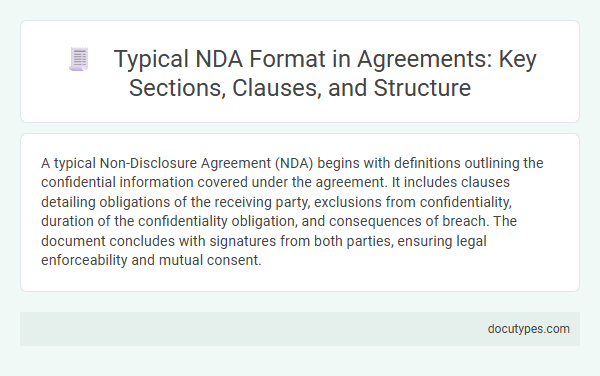A typical Non-Disclosure Agreement (NDA) begins with definitions outlining the confidential information covered under the agreement. It includes clauses detailing obligations of the receiving party, exclusions from confidentiality, duration of the confidentiality obligation, and consequences of breach. The document concludes with signatures from both parties, ensuring legal enforceability and mutual consent.
Introduction to Non-Disclosure Agreements (NDAs)
A Non-Disclosure Agreement (NDA) is a legal contract designed to protect sensitive information shared between parties. The typical format of an NDA includes an introduction defining the purpose and scope of confidentiality. Your NDA will usually begin by identifying the involved parties and outlining the information that must remain confidential.
Purpose and Scope of an NDA
An NDA (Non-Disclosure Agreement) typically begins with a clear statement of its purpose, which is to protect confidential information from unauthorized disclosure. The scope defines what information is covered, who is bound by the agreement, and the duration of confidentiality obligations. Your NDA should explicitly outline these elements to ensure mutual understanding and legal protection.
Definition of Confidential Information
The typical format of an NDA (Non-Disclosure Agreement) includes a clear definition of confidential information. This section specifies the types of data and materials that must remain private between the parties involved.
Confidential information generally covers business secrets, proprietary data, client lists, and any written or oral information marked as confidential. You must understand what qualifies as protected information to ensure full compliance with the agreement.
Parties Bound by the NDA
What is the typical format of an NDA (Non-Disclosure Agreement)? An NDA usually begins by identifying the parties bound by the agreement, specifying their legal names and roles. You must clearly define who is disclosing confidential information and who is receiving it to ensure proper legal protection.
Obligations and Duties of the Receiving Party
A Non-Disclosure Agreement (NDA) typically outlines the responsibilities and limitations of the party receiving confidential information. The format emphasizes the protection of sensitive data and the obligations imposed on the receiving party to maintain confidentiality.
Key obligations and duties of the receiving party are clearly defined to prevent unauthorized disclosure and misuse of information.
- Confidentiality Obligation - The receiving party must keep all shared information strictly confidential and avoid sharing it with unauthorized individuals.
- Use Restriction - Confidential information can only be used for the purposes specified in the agreement, ensuring it is not exploited for personal or competitive gain.
- Notification Duty - You are required to promptly inform the disclosing party if any unauthorized disclosure or breach occurs.
Exclusions from Confidentiality
| Section | Description |
|---|---|
| Title | Non-Disclosure Agreement (NDA) |
| Introduction | Identifies the parties involved and purpose of the agreement |
| Definition of Confidential Information | Specifies the types of information considered confidential under the NDA |
| Obligations of Receiving Party | Details the responsibility to protect confidential information and restrictions on disclosure |
| Exclusions from Confidentiality |
Information not subject to confidentiality obligations includes: - Publicly available information at the time of disclosure - Information already known to the receiving party before disclosure - Information independently developed without use of confidential data - Information rightfully obtained from third parties without breach of confidentiality - Information required to be disclosed by law or court order, provided notice is given when possible |
| Term and Duration | Specifies the time period during which confidentiality must be maintained |
| Miscellaneous Provisions | Includes governing law, dispute resolution, and amendment procedures |
Duration and Term of Confidentiality
The typical format of an NDA (Non-Disclosure Agreement) includes a clearly defined Duration specifying the start and end dates of the agreement's enforceability. This period usually spans from the signing date to a predetermined time after the confidential information has been shared.
The Term of Confidentiality outlines how long the obligations to protect the sensitive information remain in effect, often extending beyond the agreement's duration. Commonly, confidentiality terms last between two to five years, depending on the nature of the information and industry standards.
Remedies and Consequences of Breach
The typical format of an NDA includes clearly defined remedies and consequences for breach to protect confidential information effectively. These provisions outline the legal actions and penalties if the agreement is violated.
- Injunctive Relief - Courts may order to prevent further unauthorized disclosure or use of confidential information.
- Monetary Damages - Compensation sought for financial losses resulting from the breach.
- Termination Clause - The agreement may allow ending the business relationship if the NDA is breached.
Clear remedies and consequences ensure enforceability and deter potential breaches in NDAs.
Governing Law and Jurisdiction
The typical format of a Non-Disclosure Agreement (NDA) includes sections on the scope of confidentiality, obligations of the parties, and the duration of the agreement. A crucial part of the NDA is the Governing Law and Jurisdiction clause, which specifies the legal framework and venue for resolving disputes.
The Governing Law clause designates the state or country's laws that will apply to the interpretation and enforcement of the NDA. The Jurisdiction clause identifies the courts that have authority to hear any disputes arising from the agreement. Clearly defining these elements provides legal certainty and helps avoid conflicts over which legal system applies.
What Is the Typical Format of an NDA (Non-Disclosure Agreement)? Infographic

